The offspring of William March and Jane Harrison
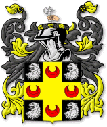 WILLIAM MARCH 1856 - 1923
WILLIAM MARCH 1856 - 1923
William March was born at Willington Quay, Northumberland adjacent the Newcastle-upon-Tyne coast road on 9th April 1856, the eldest son to William March and his wife Jane. William senior was employed as a fire-brick maker in the 1850s and 1860s, and so, moved around with his work. By the time he was four years of age, young William was living in Crook, County Durham, and over the following 20 years, found himself travelling from pit village to pit village, before settling at Craghead, County Durham in the 1880s.
He lived in Crook from around 1858 until around 1863, before his parent's moved to Bishop Auckland, County Durham. It was here, in Bishop Auckland that William was baptised on 10th March 1860. This stint at Bishop Auckland was followed by a brief stay at Urpeth Colliery, County Durham, the family being recorded here from around 1868 until around 1872. They moved to Holmside, County Durham in the 1870s and were still living here in 1881.
The Census for that year gives the March's address as 4 Double Row, Holmside. William, in 1881, was a coal miner. He is thought to have worked at Craghead Colliery, this being the usual place of work for the resident coal miners of Holmeside. Craghead Colliery, for this reason, also earned the name of Holmside Colliery. It is very likely that William March worked at either the George or the Oswald, which were sunk at Craghead in 1854 and 1878 respectively.
William married Mary Redhead at Holmside on 8m April 1882 and they spent the remainder of their lives in Craghead, the place of Mary's birth during the 1850s. She died here on 6th November 1922. In the early part of the 20th Century, William and she adopted a young man named William Frederick Hope, who in reality was a nephew, or great-nephew of Mary. Sadly, William F. Hope died young, on the 25lh June 1931 aged just 29 years old. Mary was one of five children, born to Anthony and Ann Redhead
Around 1872, a daughter was apparently born out of wedlock at Craghead, to Mary Redhead, the latter being aged about 19 years at the time. Descendants of Mary suggest that the child, named Annie Redhead was in fact the illegitimate daughter of Mary Redhead and William March. Annie was raised by her grandparents, Anthony and Ann, and always kept her maiden name of Redhead, rather than her father's name of March, even after her parents married in 1882. In 1900, Annie Redhead married Robert Mills in the district of Lanchester, with their descendants remaining in the north east to date. The story goes that Anthony Redhead was a founder member of the
Primitive Methodist Church in Craghead. He and his descendants were staunch old-fashioned Primitive Methodists, and such things as births out of wedlock were hushed up. Anthony's son-in-law, Robert Mills, and the latter's own son were trustees at the church in their time. The Preacher's Chair and Flower Vase, given in Annie's memory now reside in Lanchester Methodist Church, following the closure of Craghead Church.
According to the 1901 census, William and Mary March were living at 5 Fenwick Street in Craghead, where William worked as a Sub-Postmaster in their general dealers shop. Later records show this as Front Street. From a book, written in 1985, by Craghead resident, John Hall, it is detailed that William had lived in Fenwick Street since at least 1900, and that his shop was situated on the Front Street of Craghead, flanked by the local Draper, and the local Newsagent, in 1900, there were a total of 9 business premises on Front Street, all situated in the vicinity of the Fairground field.
Mary's two nephews, Luke Hope (born at Craghead in 1878) and William Hope (born in 1891 at Pegsworth, Morpeth) also shared these premises at Fenwick Street in 1901. The latter was still living with William and Mary in 1911. The 1881 Census shows the Hope family as living at Newfield double row, Pelton, County Durham. The head of the household was Luke Hope, born around 1849 in Tanfield, Durham. He was an engineman in the local collieries, and sadly died at Gateshead in 1895. By the time of his death, he had fathered about six children, and it appears as though his wife, Margaret (Redhead) may not have been able to cope, following her husband's demise. This is where the link between the March's and the Hope's was discovered. Luke and Margaret had been married since 1871.
When William March died at Craghead on 22nd August 1923, William F. Hope, or Billy as he was locally known, took over the post office where the March's had lived on Front Street. Billy was born with a club foot and in later years had a bulldog for company. For a long time, he was the organist at the Primitive Methodist Chapel in Craghead. He, Mary, and William March are all buried in the same grave in the village churchyard. A large white headstone marks the spot.
The Fairground area, of William's time in Craghead, provided a fair amount of entertainment for the village. Life in general was very much like any other coal mining area. At the turn of the 20th Century, there were a variety of street entertainers, that would occupy the gathering crowds, including the Dancing Bear. The bear was led through the village on a long chain by a man with a hat and a stick. Amongst other entertainers that wowed the crowds were the Organ Grinder and the German bands, which consisted of a small number of instrumental players. When the First World War broke out in 1914, these bands disappeared, and the general rumour in Craghead had it that they were German spies,
In 1900, the village cobbler was William Wilson. His shop was situated two doors from William March's post office, in Fenwick Street. William Wilson had wed Jessie Pike in 1878, she being the aunt of my Grandfather, Thomas March (1893 - 1963). The latter later worked for William Wilson or Billy Wilson as he was known.
The offspring of William March and Jane Harrison
THOMAS MARCH 1864- 1937
Thomas March was the fifth child, horn to a colliery fire-brick maker, William March and his wife Jane Ellen (Harrison). Due to his work, William would move around from one district to another, wherever the work took him. Both he and his wife originated from north of the River Tyne, but when they married, in 1853, both resided at
Hart Bushes, County Durham. Hart Bushes was in the area of Monk Hesledon, the latter containing three collieries. One of these collieries was South Wingate, which operated from 1840 until 1857. It was also known as Rodridge, or Hart Bushes. This colliery would have had its own brick factory, which was used to build the colliery houses.
Research suggests that William and Jane moved from Han Bushes and set up home in Crook, County Durham around 1855, before moving to Willington Quay, near Newcastle upon Tyne around 1857. A new brick factory opened in or near Roddymoor, Crook in 1860, and the March family again moved to Crook, and settled at Billy Row from around 1860, until about 1863. They were there in June 1862, this being the year my great-grandfather,
George March was born.
Thomas March was born at Blue Row, Bishop Auckland, County Durham in 1864. By the time he was four, he was living at Urpeth, near Chester-le-street, and remained there until at least 1872. From 1876 until 1881, the March family lived at Holmeside, Durham. The Census for 1881, lists their home address as 4 Double Row, Holmeside. Thomas, in 1881 worked as a coal miner, most likely at Craghead Colliery. This Colliery was also known as Holmeside Colliery, due to the fact that the majority of coal miners at the Craghead pit came from Holmeside. By the early 1880s, Thomas and his family had moved to Craghead village. His marriage to Mary Hannah Sayers took place in 1885 in the district of Lanchester, Durham. She was born in nearby Joicey Square, West Stanley around 1866, one of five found children to Anthony and Sarah Sayers. Following Thomas and Mary Hannah's wedding, the latter resided in Craghead, at Ousterley Farm, where their eldest child, Sarah Jane March was born in 1886. Ousterley was perhaps more of a district than part of Craghead village. It was about a mile south of Stanley and just north of Holmeside. Up until 1870, Ousterley was in the parish of Lanchester and from 1870 was in the parish of
Holmeside St John. The farm itself was situated roughly where the B6352 merged with the B6313, which also contained West and Low Ousterley. Nowadays, it is all merged into the village of Craghead. By 1887, the March family had moved to Holmeside, before, again residing in Craghead in 1888. By 1890, the March's lived in Edmondsley, staying here till the early to mid 1890s. Thomas March spoke with a very broad Northumberland accent, this being confirmed by one of his grandson's, William Ronald March in 1990. Another grandson, also named Thomas March, informed me that his grandfather was not tall in height.
In April 1901, Thomas and Mary, along with their then six children, lived in South Moor, Durham. The family first came here between 1893 and 1895. The Census for 1901 lists their address as 80 Elm Street, South Moor. A seventh child, named Henrietta March was born at this address on 4m November 1901. In October 1904, Thomas was still listed at 80 Elm Street, when he acted as the informant on his father's death certificate. A further two children were born in South Moor between 1906 and 1908. Two earlier children were born, and died between 1892 and 1896. In 1911, Thomas and Mary still lived in South Moor, at 25 Lime Street. Thomas worked as a winding-engine man at this point. None of their children were married by that year. However, only one son shows at the family home in 1918, that being William. The electoral register for 1918 lists their address as 22 Fourth Street, South Moor. No war records have yet been found for Thomas, and it is thought that following World. War One, Thomas and his family moved to the village of Lanchester. Here, he worked in the collieries as a Winding Engine man. Thomas' grandson once told me that his grandfather had died in 1938, at Lanchester, and death records now prove the year of death as 1937. The full list of his offspring were as such: -
Sarah Jane March - Was born in 1886 at Osterley Farm, Craghead, which is situated to the left of the crossroads at Craghead, heading north bound. Sarah is thought to have married James Owens in 1912. Two possible children have been found from their union, these being Daisy Owens (born 1913) and Cecil Owens (1917 - 2000).
Thomas March - Was horn in 1887 at Holmeside, Durham. He married Alice Ann Heslop in 1912 and there were three children to this couple. They were Leslie March (born 1914), William March (1918 - 1992) and Thomas March (horn 1923). The latter is believed to be currently living in the village of Lanchester, Durham. On 9lh March 1941, at South Moor, William married Mary Cox. The latter was one of 5 found children to John Cox and Lizzie Isabel Dixon, these two marrying in 1906.
Anthony March - was born in 1888 at Craghead, Durham. He married Elizabeth Ellen Lewins in 1915 and they shared two offspring, named Anthony and Rose M. March, born in 1917 and 1920 respectively.
William March - was born in 1890 at Edmondsley, Durham. He wed Annie McMahon in 1919, and two children were born from this marriage, named William Ronald March (1922 - 1999) and Evelyn March (born 1925). William Ronald lived out his final years at Oswald Street, Craghead.
Annie March - was born in 1891 at Edmondsley, Durham. She possibly married John G. Thompson in 1919. One daughter shows on the birth records, that being Mary Thompson in 1920.
George March - was born in 1892 at Edmondsley. Durham. He died there in 1893.
Mary Hannah March - was born in 1895 at South Moor. Durham. She died there in 1896.
Elizabeth March - was born in 1897 at South Moor. Durham. Elizabeth is thought to have wed William J. Harrison in 1921.
Henrietta March - was born on 4th November 1901 at South Moor, Durham. She wed John Wright in 1920, but he died suddenly in 1921. They shared one son, Harry Wright (1920 - 1988). Henrietta died in 1961.
George Harrop March - was born in 1906 at South Moor, Durham. George married Frances Ethel Woodhouse in 1927. There were three children to this marriage, named George March (1927 - 1999), Alan March (born 1929) and. James March (born 1937). Frances died in 1961, and George died earlier, between 1954 and 1956.
Ruby March - was born in 1908 at South Moor, Durham. She died in County Durham in 1990. Ruby wed William Arthur Eccles in 1928. They had one son named Thomas W. Eccles, born in 1929, and a possible son named William Eccles, born in 1947, but the latter is not certain as yet.
The tracing of Thomas March (1864- 1938)
1864: Blue Row, Bishop Auckland, Durham.
1868 - 1872: Urpeth. Durham.
1876- 1881: Holmeside. Durham.
1886: Craghead. Durham.
1887: Holmeside, Durham.
1888: Craghead, Durham.
1890 - 1893: Edmondsley Durham.
1895 - 1900: South Moor, Durham.
1901 - 1904: 80 Elm Street South Moor, Durham.
1911: 25 Lime Street. South Moor, Durham.
1918: 22 Fourth Street, South Moor, Durham.
1937: Lanchester. Durham.
The offspring of William March and Jane Harrison
MARY AGNES MARCH 1869 - 1932
Mary Agnes March was born in Usworth, County Durham on 25th December 1869, the seventh child born to a fire-brick maker, William March and his wife Jane. She was named out of respect to her elder sister, Mary Ann who, at the age of 13 had died in 1868, presumably in Usworth. The March family, due to work moved from village to village on numerous occasions, before settling in Craghead in the 1880s. As a child, Mary Agnes lived in Usworth until moving to Urpeth Colliery at some point around 1871. By the mid 1870s, her parent's had moved to
Holmeside parish, County Durham, where they are recorded in 1876 until at least 1881. In that latter year, the 1881 Census lists their address as 4 Double Row, Holmeside.
Where Mary Agnes lived from 1881 until 1887 is unknown at present, but she married Robert Watson-Gill at Lanchester, County Durham on 18th April 1887. He originated from Beech Burn near Crook, County Durham, being born there in 1866, the youngest of eight children to Robert Watson Gill and his wife Alice. The latter lived from 1828 - 1873, while her husband died in 1892 aged 65.
Following their wedding, Mary Agnes and Robert settled in Craghead, and lived here from 1887 until 1901, with a brief stay in nearby Humble Burn, near Blackhouse in 1890. By 1892, they were back in Craghead, before moving to Shotton Colliery around 1902. Here they remained until at least 1908 before returning to Craghead by 1911. Approximately 13 children were born to Mary Agnes and Robert, with two of them dying in Shotton in 1905.
Robert Watson Gill was a stoneman at Craghead Colliery in 1928. On 14th September that year, he had an accident at this colliery, probably due to a stone - fall. He died some months later, on the 26th June 1929 to be exact. The cause of death was attributed to the injuries he sustained in the colliery. He was buried in St. Thomas' Churchyard, Craghead on 29th June 1929. Mary Agnes' own death followed just over three years later, on 4th November 1932.
The children born to Robert and Mary Agnes Gill were as follows:-
Robert Watson Gill - born Craghead in 1887.
Alice Gill - born Craghead in 1888.
William March Gill - born Humble Burn in 1890.
John Gill - born Craghead in 1892. Died in 1962.
George Gill - born Craghead in 1893. Died in 1970.
Matthew Herbert Gill - born Craghead in 1896
Thomas Gill - born Craghead in 1898.
Joseph Gill 1900 - born Craghead in 1900.
Jane Gill - born Easington area in 1902. Died there in 1905.
Edward Gill - born in Easington district in 1904 and died there in 1905.
Elizabeth Gill - born Shotton Colliery in 1906.
Edward Gill - born Shotton Colliery in 1908.
Leslie Gill - born Craghead in 1911.
GEORGE MARCH 1862 -1938
My great- grandfather was born at South Street, Crook on 30th June 1862, the fourth eldest child of ten, to a fire 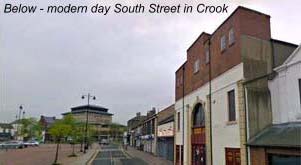 brick maker, William March, and his wife Jane. George was conceived before evening, this being evident from his birth certificate which had been issued the same day. As a youngster, it is admissible that George was never to settle in one place long enough to call home, and due to William's employment, the family found itself moving from village to village on an almost permanent basis. Crook had been the home of William and Jane since the mid-1850s, with a brief interruption occurring around 1856, when they lived at Willington Quay near Newcastle upon Tyne. By 1859 they had returned to Crook, living here until the early 1860s.
brick maker, William March, and his wife Jane. George was conceived before evening, this being evident from his birth certificate which had been issued the same day. As a youngster, it is admissible that George was never to settle in one place long enough to call home, and due to William's employment, the family found itself moving from village to village on an almost permanent basis. Crook had been the home of William and Jane since the mid-1850s, with a brief interruption occurring around 1856, when they lived at Willington Quay near Newcastle upon Tyne. By 1859 they had returned to Crook, living here until the early 1860s.
In 1864, George March lived with his parents at Bishop Auckland, but this stay was brief, and by 1867 they had once more moved, this time to the area of Washington where the March family resided in Usworth.
It was probably at Usworth Colliery that George’s working life began, and by the age of 8 he was working as a Colliery labourer at Urpeth Colliery where his parents had moved to, around 1870.
Urpeth started its life as a coal mining area and its colliery had a life span from 1835 until 1957. In the 1860s it was owned by Hunt, Perkins and Company. Geographically, Urpeth is situated to the west of Ouston and is surrounded by fields and rolling hills. However, because of its position on the landscape, one cannot see Ouston, due to a hill that blocks the view. This hill was formed from the coal spoils from both the Ouston and Urpeth Collieries.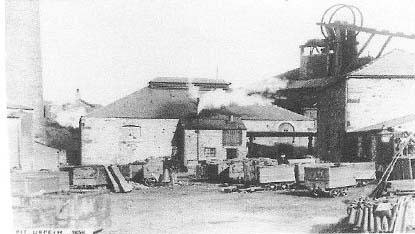
Right – Urpeth Colliery where George March worked in 1871.
From around 1876 until 1881, George March lived with his parents at Holmside, and in that latter year, resided at 4 Double Row. These houses, and indeed the village itself did not come into being until the late 19th Century. To the south of the village was another hamlet called Warland Green. This was a medieval name meaning taxable land, which once belonged to a Villein or feudal tenant. Warland Green was still thriving in the mid 1800s when its buildings were clustered around the Wardles Bridge Inn, which still stands to date.
Holmside was occupied by miners who worked at Nearby Craghead and Edmondsley as well as a few workers from Sacriston Colliery, but it was the former, Craghead, that 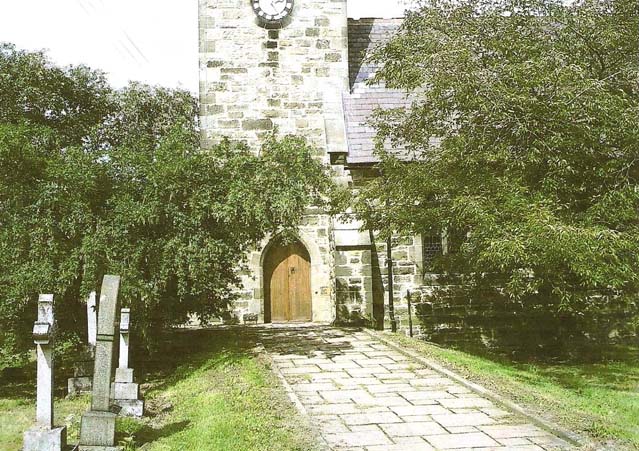 was often referred to as Holmside Colliery, and it was here that George worked in 1882, the year of his first marriage. It is unclear if George was still living in Holmside or Craghead in 1882, but his marriage certificate states his abode as Craghead. On 27th August 1882, George married Elizabeth Pike at St. John's Church in Burnhope. This church, built in 1865 was situated 2 miles from Holmside, and served Craghead, South Moor, and Burnhope itself.
was often referred to as Holmside Colliery, and it was here that George worked in 1882, the year of his first marriage. It is unclear if George was still living in Holmside or Craghead in 1882, but his marriage certificate states his abode as Craghead. On 27th August 1882, George married Elizabeth Pike at St. John's Church in Burnhope. This church, built in 1865 was situated 2 miles from Holmside, and served Craghead, South Moor, and Burnhope itself.
Right – St John's parish church at Burnhope, where George married Elizabeth in 1882
Elizabeth Pike, born 12m August 1861, was the daughter of a Devonshire coal miner named Andrew Henry Pike. The latter originated from Buckland Monochorum in 1833, but had lived in Holmside since around 1875. In 1881, the Pike family lived 15 doors away from the March family in Holmside, the former residing at 19 Low Row. It is of note, regarding the wedding certificate of George and Elizabeth, that the witness' were named Mary Ann Robson and Robert McAdoo. Mary Ann Robson lived from 1864 until 1907, and had she lived, would have become the mother-in-law of George and Elizabeth's son, Thomas March, when the latter married Mary Ellen Laidlow in 1913. Robert McAdoo, one the other hand, had lived with the March family since their days at Holmside Village.
Following their wedding, George and Elizabeth made their home in Craghead where all their offspring were born between 1884 and 1902. Their most noted address over this period was at 26 Railway Street, but prior to this they had lived at 21 Thomas Street, situated behind Craghead Front Street. These were all relatively new houses and in 1854, an Ordnance Survey map marked the hamlet of Crag-head at the junction of a lane, marked on the map as Craghead Lane and Wagtail Lane, with another lane running south-east towards Wheatleygreen Lane and Holmside Lane. Due to its late development, Craghead does not appear in early trade directories. The busiest street in Craghead, during George's era, was probably Edward Street. In general, Craghead does not have a long history, its first colliery, the William Pit, being sunk in 1839, and ceasing in 1968. The area, like Sacriston, really only developed with the introduction of the local collieries.
Around 1896, George and Elizabeth March moved into 26 Railway Street, on the brow of the bank that overlooks the church of St. Thomas. However, back then, the area where the church stands was mainly fields with a farm in the near distance. To get some idea of the living conditions and general layout of the houses where the March family lived, we can refer to John Hall's 'History of Craghead', written in 1985.
Mister Hall vividly describes the first colliery houses built in Craghead, these being in Wagtail Terrace. They were built at a cost of 45 pound each and were set in rows. Each house had two rooms; the upstairs room, reached by a ladder, had no ceiling and the roof beams were exposed, this room referred to as the 'garret' or ‘loft'. The downstairs room was paved with red flagstones, a large fireplace with a set-pot for hot water on one side and a round oven on the other. There was only one door, a window to each room and the one downstairs fitted with a wooden shutter secured by a bolt and cotter pin. In between the rows of houses were the ash-pits and closets. Other streets, such as Thomas Street, William Street and Edward Street were built just after Wagtail Terrace, and were of similar design. 26 Railway Street, however, consisted of 3 rooms.
George and Elizabeth were the parents of seven offspring. Their eldest child, William March was named after his grandfather, being born 14th March 1885. William immigrated to Utah in 1921, and this is the last time George saw his son. However, his remaining six children, Grace, George, Thomas, Elizabeth, Henry, and Hilda all remained in England until they died. At the turn of the new century, George still worked as a coal miner in Craghead, while his son, William, was employed at Charlaw Colliery. On 13th April 1905, Elizabeth March died at 26 Railway Street from 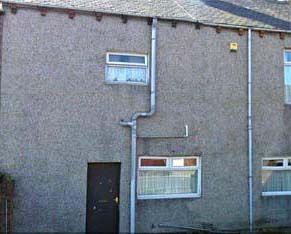 heart disease aged just 43. Elizabeth is buried in Pelton Churchyard in grave number OF175. This is also the resting place of her daughter, Grace, who died in December 1952. The Church at Craghead did not open until 17 July 1911, but its burial ground had opened earlier, in 1907, so the choice of Elizabeth’s internment was that of Pelton or South Moor. When she was buried in 1905, no headstone was laid, and her name actually shows up on the headstone of George March even though he himself is buried in a single grave.
heart disease aged just 43. Elizabeth is buried in Pelton Churchyard in grave number OF175. This is also the resting place of her daughter, Grace, who died in December 1952. The Church at Craghead did not open until 17 July 1911, but its burial ground had opened earlier, in 1907, so the choice of Elizabeth’s internment was that of Pelton or South Moor. When she was buried in 1905, no headstone was laid, and her name actually shows up on the headstone of George March even though he himself is buried in a single grave.
Right – Modern day 26 Railway Street, Graghead.
This was the second time in the space of 6 months that George had attended Pelton Churchyard for a funeral possession, as on 20th October 1904, his father; William had been buried there, in the next grave to Elizabeth. George March re-married on 4th June 1910. His wedding to Isabella Chapman took place at Stanley Chapel, Shield Row. The latter, nee Isabella Hall, had previously married Richard Weatherby Chapman in 1892, but he died in 1908, leaving Isabella and four children. In the first decade of the 1900s, Isabella and her family had lived at Blackhouse, but following her wedding to George, she and her sons went to live at 26 Railway Street. It must have been a quite compact house in respect that it only had three rooms, and the total number of persons living at this abode in 1911 was ten.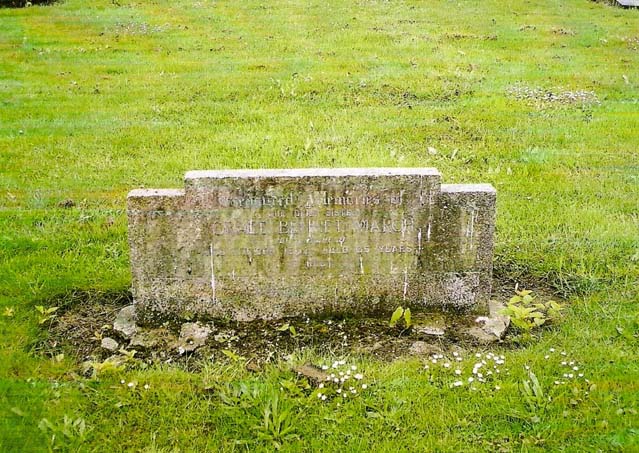
Right – the remains of Elizabeth March lie directly beneath those of her daughter, Grace Bennet March
Isabella had four children in total, three sons and one daughter. The latter, named Florence, sadly died in 1909 aged just 13, but her three surviving sons, John Thomas (1894 -?), Robert Hall (1898 - 1971), and Arthur Rudolph (1902 - 1976) all lived at 26 Railway Street in 1911. In later years, it is recalled that the surname of Chapman was possibly a taboo with my great-grandfather's descendants, but it is unclear in what capacity. By 1911, George's daughter, Grace, had moved out of 26 Railway Street and went to live in South Stanley. His son, William had married in 1909 and was living in Old Penshaw in 1911, and by 1913, Thomas March had also left the family fold, following his marriage to
Mary Ellen Laidlow.
Village life in my great-grandfather's time was quite a busy affair. Of course, everyday events circulated around the pit and the most important man in the village was probably the 'Caller - up'. It was very necessary to arrive at the pit - head at the correct time to descend, for if you didn't, you could lose a shift because coal drawing had already begun. To get called up for work, George had to chalk the time on his front door or garden gate. The 'Caller - up' would then knock with his heavy stick and wait for an answer before leaving. He used his usual words, 'Are you up?’, and if you were in a downstairs house, the 'Caller - up' would add the word 'Downstairs'.
Families in Craghead were very close by the very nature of the work. Any family who had suffered bereavement could be assured of sympathy and help from their neighbours so much so that it was customary to engage two bidders to go and invite neighbours to attend the funeral. The bidders would also walk ahead of the cortege and its procession. After the funeral anyone who attended was welcome to a meal and to take the opportunity of expressing their sympathy. One noted funeral to take place in Craghead occurred in 1887, when on 27th September that year, Mary Ann Potter, aged 44, and her son, George, aged 5, were killed when struck by lightening. A thirteen-week strike also occurred in Craghead in 1891, causing great hardship to the miners.
After working in the foul air, and cramped conditions of the pit, George March would most likely be glad to get out into the fresh air and the open spaces. He would have found time relaxing by walking or gardening, and sometimes may have preferred to meet up with the other miners at the 'Corner End' of the village. This custom became so established between miners that the authorities erected seats of wooden planks at street ends or convenient spots frequented by the coal miners. Entertainment for local talent was often held in the Hedley Memorial Hall, built in 1902, and at the turn of the 20th Century, in Craghead, street entertainment was a regular occurrence. George would have, at some point witnessed the dancing bear and the organ grinder as well as the harmonious small German bands that appeared in the village prior to World War One. George March was 52 when the First World War broke out and he continued working as a coal miner through-out the conflict. It is not known how many of his offspring fought in the War, but from records, his son, Thomas served as a private in the Northumberland Fusiliers. This evidence is given on the birth certificate of my father in 1918.
On January 1st 1920, George attended the wedding of his daughter, Elizabeth Hannah, at St. Thomas' Church in Craghead. Following her marriage to James Arthur Snowball, they moved to Southwick near Sunderland, where 4 grandchildren were born to George, between 1920 and 1926. How many of his grandchildren, twelve in total and one adopted child, George ever got to meet are open to speculation. Below, is the full list of the grandchildren of George and Elizabeth March: -
Marion March - born 1910. Daughter of William March.
George March - born 1914. Son of Thomas March.
Lawrence Bradshaw March - born 1915. Son of William March.
Thomas March - born 1915. Son of Thomas March.
Mary Elizabeth Hancox - born 1917. Adopted daughter of Henry March.
James March - born 1918. Son of Thomas March.
Arthur Snowball - born 1920. Son of Elizabeth Hannah March.
Hilda Snowball - born 1923. Daughter of Elizabeth Hannah March.
Doris Snowball - born 1924. Daughter of Elizabeth Hannah March.
Henry March - born 1926. Son of Thomas March.
John Snowball - born 1926. Son of Elizabeth Hannah March.
George William Cruddas - born 1930. Son of Hilda March.
Sheila Cruddas - born 1934. Daughter of Hilda March.
George retired from working around 1925, and some point after that, he and Isabella moved into the Aged Miners Homes near The Middles. These homes had been built around 1923. It was here; in June 1938 that George suffered a 'stroke', caused by high blood pressure and arteriosclerosis. He died on 6 June 1938 and was buried at Pelton on 9th June that year in grave number C267.
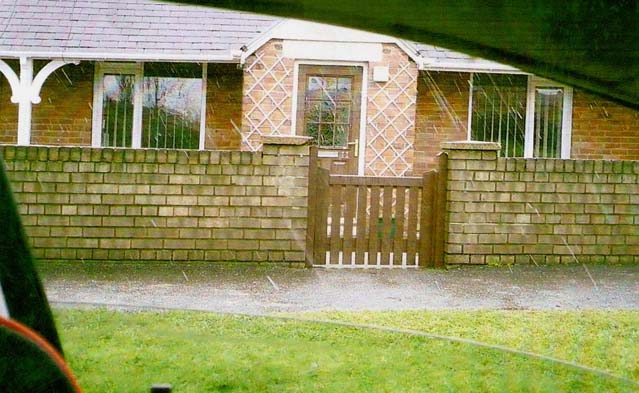
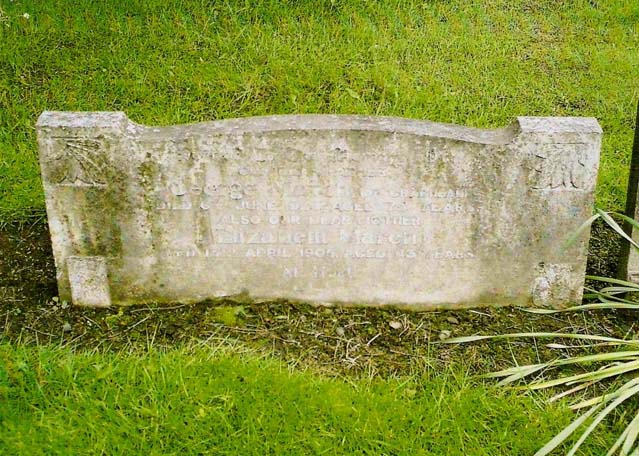
Above left – 11 Aged Miners Homes, Craghead, where George March died on 6th June1938
Above right – the grave of George March at Pelton Graveyard
The offspring of George March and Elizabeth Pike
GRACE BENNET MARCH (1887 -1952) - was named after her grandmother, Grace Bennet Williams who lived from 1838 until 1905. Grace Bennet March was born in Craghead in July 1887 and lived with her parents until the first decade of the 20th Century, before taking up the post of Domestic Servant at 3 Murray Street in West Stanley, the home of a piano tuner, Joseph Bulman. Grace never married, and in 1947 lived with her widowed sister, Hilda Cruddas at 17 Larch terrace near the Middles in Craghead. Grace died on 11th December 1952 in Durham North West, aged 65 and was buried on top of her mother Elizabeth in Pelton graveyard (grave number OF 175). A headstone marks her grave. At some point, it is thought that Grace may have been involved in nursing but this is uncertain.
GEORGE MARCH (1889 -1928) - was named after his father, being born in June 1889 at Craghead. George earned a living as a pitman and lived with his widowed father at 26 Railway Street until the former moved to 20 Ladysmith Terrace in Craghead, where he died in September 1928 aged 39. George never married and was buried in an unmarked grave in St. Thomas' Churchyard, Craghead on 23rd September that year.
ELIZABETH HANNAH MARCH (1896 -1965) - was born in 1896 at Craghead. 'Lizzie' lived with her widowed father at 26 Railway Street until her marriage in 1920. On 1st January that year, she wed James Arthur Snowball at St. Thomas' Church, Craghead and then moved to Southwick near Sunderland where they lived until Elizabeth's death. Elizabeth and James shared 4 children, all born in Southwick - these being named Arthur (1920), Hilda (1923), Doris (1924), and John (1926). Elizabeth was a well-built lady with a nice personality, and she died on Good Friday 1965 following a road accident in the Sunderland area, at which my parents attended her funeral.
HENRY MARCH (1898 -1967) - was born in 1898 at 26 Railway Street in Craghead. In 1924, 'Harry', as he was known, married Alice Isabel Hancox. They had no biological children, but Alice did have a daughter, born out of wedlock in 1917, who was named Mary Elizabeth Hancox, being nick-named Polly for short. When the latter herself married, in 1936, she used the surname of Hancox. Mary may at some point have called herself March, which led to my grandfather (Henry's brother) insisting that Polly's surname should have been Hancox, and never March. From at least 1949, Henry and Alice lived at 9 West Street in Grange Villa, and even after Alice's death in 1954, Henry continued to live at that address until 1965. Alice had died on 11th January 1954 aged 55 and was buried in Pelton graveyard on 15th January that year. She is buried in grave number B82. It is thought that Henry may have moved to Pelton around 1966. He was going blind in his old age and passed away in 1967 in Durham Central, but it is currently unknown where he was buried. Henry was described as a very nice, kind gentleman. In 1936, Mary Elizabeth Hancox had married Norman Lovely, a South-Shields born coal miner, and following their wedding, Mary and Norman went to South Shields to live. Norman died in 1958 in South Shields, followed by Mary in 1972 in the same area. They shared 4 children from their marriage, these being named Audrey (1937 - 1939), Norman (born 1939), Melvyn (1943 - 1997), and Brenda (born 1948). Both Audrey and Melvyn died in South Shields.
HILDA MARCH (1902 -1979) - was born at 26 Railway Street, Craghead in 1902. Following her mother's death in 1905, Hilda remained with her father and in 1930, married Charles Birnie Cruddas, setting up home at 17 Larch Terrace near the Middles in Craghead, still living at that address in 1974. In 1947, Hilda lived at 17 Larch Terrace with her sister, Grace. Hilda and Charles had two children named George William Cruddas and Sheila Cruddas. The former was born at Craghead on 29th June 1930 and died in 1986 while Sheila was born in Craghead in 1934. Charles Birnie Cruddas died at Larch Terrace in 1935 and was buried in St. Thomas' graveyard at Craghead, but Hilda never remarried, herself dying in Durham Northern in 1979; it is not yet known where she is buried. In 1946, my father was discharged from the army, and stayed for a while with Hilda at 17 Larch Terrace before returning to his parent's home at Blackhouse Village. My mother described Hilda as not being very tall and having an unpleasant personality, this being on the one occasion they met, at my parent's wedding in 1959. In 1962, at Craghead, the Fawcett Hill Chapel amalgamated with the former Primitive Methodist Chapel. At this point, Sheila Cruddas was an active member of the church in Craghead. The family line of Charles Birnie Cruddas can be traced to Yorkshire, to the great-grandfather of Charles, a man named George Cruddas, born about 1806. In the 1840s, the Cruddas line was living in Doncaster and moved to County Durham around the mid 1860s, living at Urpeth. Charles himself was born here in 1899, being baptized at West Pelton on 27th August that year. In a booklet of memories, written by a relative of mine, Robert Wilson of Craghead, the latter remembered Archibald Cruddace, the brother of Charles. Archie, as he was locally known served in World War One alongside the noted private Michael Heavyside of Craghead, with the latter winning the Victoria Cross for bravery in the field. Archie, however never won anything so gallant, but for his troubles on the field of war he had both his legs blown off. Archie died in 1950 in the Durham Northern area.
CONTINUED on W. MARCH 1885